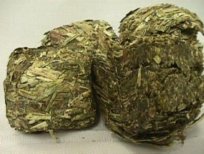Week 6
Feed Processing
|
 |
 |
Forage Processing
Instructions for listening to audio clips
- Download the QuickTime
Player to listen to the audio files.
- Read the QuickTime
Instructions for installation help.
- Download the RealPlayer to listen to the audio files
- Instructions are on the RealPlayer download page
Text Transcript
Follow along with the audio...
- Baling – tightly tied dried forage wafers
- Increases density for handling, storage
- Chopping – cutting forages into small pieces
- Aids in mixing with other ingredients
- Can improve intake and digestibility of lower quality forages
- Pelleting – pushing chopped forages through holes to create pellets
- Usually larger than grain pellets
- Can incorporate other ingredients for a “complete” feed
- Cubing – making 2” x 2” square pellets
- Easier to handle than baled hay
- Fairly expensive and slow, uncommon except for export products

- Drying, dehydration
- Reducing field losses of forages by artificial drying
- Usually pelleted as part of process
- Field kernel processing
- Roller mill on corn silage harvester to crush kernels for better
digestibility of starch in corn silage
|

